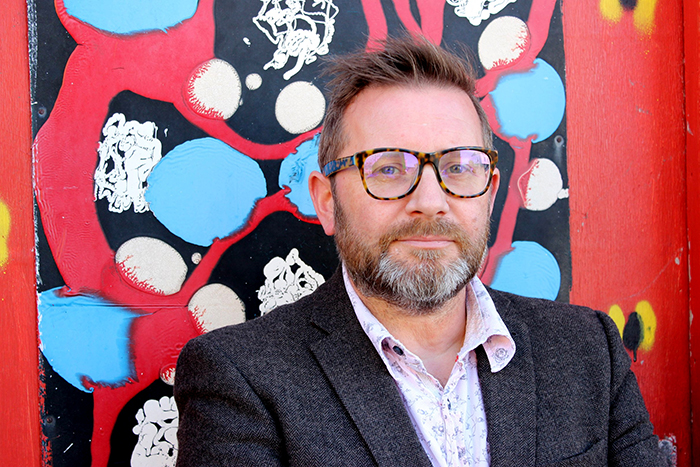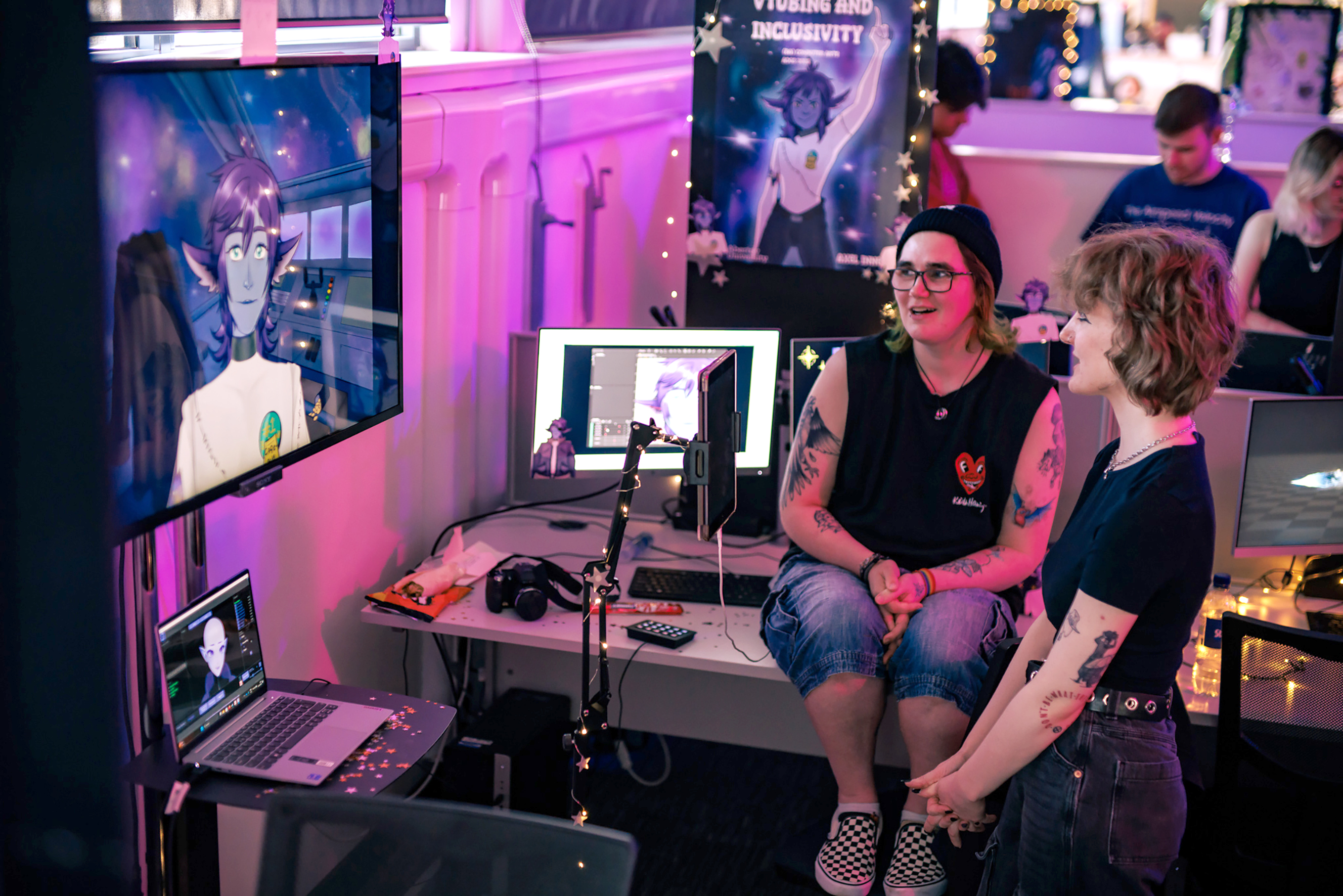Game on: Will Scotland lead the sector's next economic boom?
The room is buzzing. It’s showcase day, the culmination of a year’s worth of sweat, code, and ambition.
At Abertay University’s digital graduate show, I meet David Jackson. He’s standing by a glowing screen, quietly demoing his game to a small crowd of curious students, and maybe even a scout or two from the industry. I wait my turn to play It’s not fair, a single-player game designed to help the user manage grief. It follows the story of a small boy running from a monster – grief itself – and learning to face it. Oddly emotional, and something that I, like many, could have used at some point in my life.
A couple of tables over I find Raymake, a 3D interactive recreation of the 1990s gaming hit Rayman. Thomas Pickford, the student behind the project, describes it as a “dream come true.” He’s learned how to modernise both the audio and visuals while staying true to the game’s original charm, aiming to “modernise” it to meet current industry standards. His time at Abertay has allowed him to step outside his comfort zone as a 3D artist, developing the skills to “take on a full game design project” solo, and hopes to take his “passion project” even further.
They are two of many promising graduates hoping to break into an industry worth around £350m to Scotland’s economy.
Scotland has long had a global reputation for gaming, first sparked in 1991 by DMA Design’s Lemmings and then by its Grand Theft Auto (GTA) – now the fifth best-selling game franchise of all time. Brian Baglow, a member of the original team, recalls: “We did struggle. The publisher wanted to cancel it several times.” Nearly three decades later, GTA’s legacy still looms large, but so do industry challenges. “The sector is not as cherished or supported as it could be”, he says.
Baglow has become a key spokesperson for the industry, leading the action plan – set to be presented to ministers in the coming weeks – that will be the first step to Scotland’s long-awaited gaming strategy, announced by the Scottish Government last year. “We have a golden opportunity,” he says, “not just to build on Scotland’s legacy but to reimagine games as a crucial industry in Scotland’s future... It is our secret weapon.”
Despite political praise, with business minister Richard Lochhead calling it a “testament to our innovative spirit,” the industry remains fragmented. Sitting under the culture portfolio, it often fails to “receive any kind of focused attention,” Baglow tells Holyrood. “We’re not represented, we’re not being recognised for what’s there, and there’s no dedicated support or funding for games anywhere in Scotland.
“We’ve really not had any kind of collective voice. We have a real lack of visibility.”

Brian Baglow, founder of the Scottish Games Network and Scottish Games Week
| Brian Baglow
To date, developers have depended on broad creative and tech sector initiatives for support. While these have offered some help, the forthcoming action plan calls for targeted investment to secure the sector’s long-term survival.
Dr Dayna Galloway, head of games and arts at Abertay, echoes the call for support, particularly in education: “I think selfishly for us, it’s more about how universities are funded. I think we’re such a core part of the talent pipeline... particularly in educating creators of games to be ethical, thoughtful, have their voice within games... So, I think the more challenging it is for us to attract good students and keep students, then that creates an issue for the pipeline, and then I do wonder where the industry goes if they’re not getting these informed people coming in and shaping things.”
Rob Madden, creative director and co-founder at Hyper Luminal Games echoes Galloway’s thoughts: “Games are a proven strength for the creative economy in Scotland and our games-focused universities like Abertay play a key role, not just in terms of educating the workforce but also providing the research and development expertise needed to support growth.”
Madden began his company as a student at Abertay, and has since grown it into one of Scotland’s largest studios. He adds: “While funding support for the sector is essential, it’s also worth remembering that vibrant games ecosystems are built around the interactions between games developers, where new concepts and ideas flourish through the likes of open game jams, student events and industry meet-ups – it’s that creative community network that’s so important to the design process and a great end product. Our growth into Scotland’s largest work-for-hire studio has absolutely been founded on taking on the right projects, hiring talented people and investing in them as employees.”
 Students enjoying Abertay University's digital graduate show | Abertay University
Students enjoying Abertay University's digital graduate show | Abertay University
Back at the graduate show, Shaun Tobyn shows me his project, a 3D environment reflecting the lives of those happily working in the sex industry. His game feels especially relevant with Alba MSP Ash Regan’s Unbuyable bill currently making its way through parliament. The proposed legislation, which would criminalise paying for sexual services, has sparked division across the country and within the sex industry itself.
A game like Tobyn’s could inform the debate and Abertay University offers strong industry links. However, the recent slump in the gaming industry, including global layoffs, has instilled a fear in him that a career in the sector is out of reach. “There’s not a lot of jobs, especially junior positions – there’s next to nothing. And even the ones that are there, there’s so much competition, it feels impossible to get a breakthrough”, he says. “I’ve been applying to graduate schemes in banks – I’m almost certain I won’t make it in the industry.”
The sector is not as cherished or supported as it could be
At the other end of the hiring process is Jade Law. Her studio, Wardog Armory, launched in 2020 and supports global franchises like Call of Duty (COD). It made around three quarters of all the guns that appeared in COD’s 2024 game Black Ops 6.
“There are very few junior roles in the industry right now,” Law explains. “I’ll hire as many as I can find.” She’s concerned about the challenges new graduates face. Many attempt to go solo, hoping to create their own path - but without solid business knowledge, Law fears they’re “set for failure from the get-go.”
Ranked among the top 10 international schools for video game design by The Princeton Review, Abertay's world-renowned reputation draws multiple scouts to the show. However, the Dundee institution is just one of eight universities offering gaming courses, with an additional 11 colleges providing HNC and HND-level qualifications. Tobyn’s and Law’s experiences reinforce Baglow’s argument that “the education pipeline and industry are not connected particularly well yet.” More still needs to be done to help universities build and sustain strong ties with Scotland’s award-winning games industry, enuring they have the resources to inspire and equip students for the upcoming golden age of gaming.
As Chris van der Kuyl, co-founder of 4J Studios - creators of the console version of Minecraft - says: “It’s really important that our colleges and universities are supported to keep on providing that graduate talent pipeline which our studios depend on, but also that the sector and government work together to create the best possible conditions to drive economic growth and diversification.”
And Baglow hopes to soon solve this gap in entrepreneurship knowledge and communication. Before our call, he spent the morning finishing an application for the Scottish ecosystem fund for a project he calls “HelloWorld”, a summit where students will connect with business and funding partners.
 Jeremy Wong showcasing his games Forget Me Not | Abertay University
Jeremy Wong showcasing his games Forget Me Not | Abertay University
As I continue exploring the show in Dundee, another project catches my eye – Forget Me Not by Jeremy Wong. Inspired by his grandmother who has Alzheimer’s, the project represents the struggles of living with the disease through a depiction of her flat, blending the place she remembers and the one she currently inhabits.
Wong’s, Jackson’s, and Tobyn’s projects prove the gaming industry’s potential extends far beyond entertainment. They hint at a future where games generate not just revenue but real-world impact, from healthcare to education. Baglow even believes games can help tackle child poverty.
“It’s not necessarily about teaching kids how to make games, but how games are used to help develop different skill sets and find different areas of interest,” he says. “Every primary school child in Scotland has access to a digital device. My son is eight and he’s got a Chromebook, and when I discovered he was getting one from the school, I said ‘fantastic, we’ll get Scratch installed, we’ll start making games’. But it’s all locked down. And so all they’re really able to do is access a relatively limited range of educational software.
“We’re not empowering them, we’re not helping them to become digital creators... I think we have a much bigger opportunity to use games to not only help children learn different skills, but also learn differently”.
To understand where gaming is going next, I head to Water’s Edge in Dundee. The dockside space is home to some of the country’s top studios, like 4J Studios, creators of the console version of Minecraft, and Team Terrible, the minds behind viral horror hit The Baby in Yellow. At the far end is CoSTAR Realtime Lab, a UK Government-backed facility that signals a major shift in how game technology is used.
Inside the darkened space, three towering screen panels glow, part of the facility that could soon become the backbone of the UK’s creative industries. The lab gives creators access to high-end real-time technology – the same kind used in gaming – to build TV and film sets.
“The film industry is [worth] like $80 or $90 bn a year for feature films. The games industry is $180bn, but now, as far as we’re concerned, it’s one quarter of a trillion-dollar industry. That’s what we’re aiming for,” Matt Bett, co-investigator at the lab says.
His colleague and co-investigator, Phillip Vaughan, adds: “We’re not moving away from games but we’re shifting the focus. We’re bringing worlds together. You couldn’t have done this even a few years ago. The technology wasn’t ready. Now the puzzle is complete. The only limit is your imagination.”
Holyrood Newsletters
Holyrood provides comprehensive coverage of Scottish politics, offering award-winning reporting and analysis: Subscribe